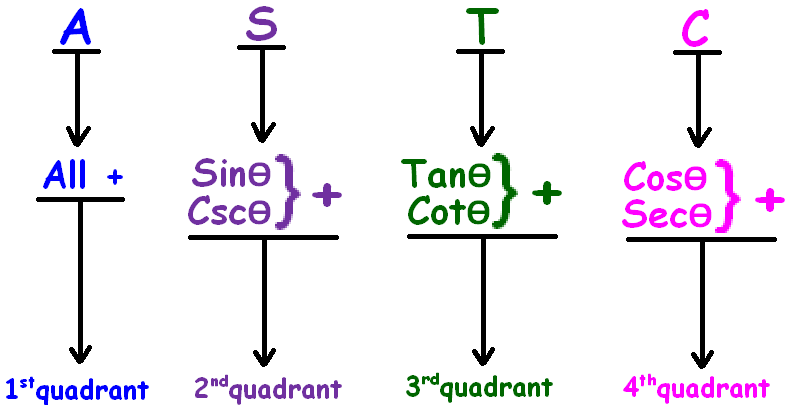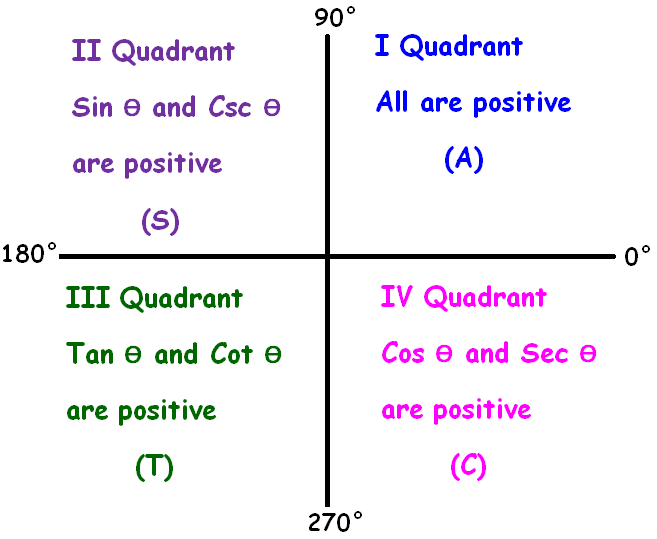TRIGONOMETRIC RATIOS OF NEGATIVE ANGLES
Trigonometric ratios of negative angles is a part of ASTC concept in trigonometry.
The results of trigonometric ratios for negative angles are given below.
sin (-θ) = - sin θ
cos (-θ) = cos θ
tan (-θ) = - tan θ
csc (-θ) = -csc θ
sec (-θ) = sec θ
cot (-θ) = - cot θ
Let us see, how the trigonometric ratios of negative angles are determined.
To know that, first we have to understand ASTC formula.
The ASTC formula can be remembered easily using the following phrases.
"All Sliver Tea Cups"
or
"All Students Take Calculus"
ASTC formula has been explained clearly in the figure given below.

More clearly

Key Concept - Negative angles :
Whenever we have negative angles in trigonometric ratios, we have to assume that it falls in the fourth quadrant.
In the fourth quadrant ( - θ or 360° - θ ), cos and sec are positive and other trigonometric ratios are negative.
Important Conversions
When we have the angles 90° and 270° in the trigonometric ratios in the form of
(90° + θ)
(90° - θ)
(270° + θ)
(270° - θ)
We have to do the following conversions,
sin θ <------> cos θ
tan θ <------> cot θ
csc θ <------> sec θ
For example,
sin (270° + θ) = - cos θ
cos (90° - θ) = sin θ
For the angles 0° or 360° and 180°, we should not make the above conversions.
Evaluation of Trigonometric Ratios of Negative Angles
Problem 1 :
Evaluate :
sin (-θ)
Solution :
sin (-θ) can be written as sin (0° - θ)
That is, sin (-θ) = sin (0° - θ).
To evaluate sin (0° - θ), we have to consider the following important points.
(i) (0° - θ) will fall in the IVth quadrant.
(ii) When we have 0°, "sin" will not be changed as "cos"
(iii) In the IVth quadrant, the sign of "sin" is negative.
Considering the above points, we have
sin (-θ) = sin (0° - θ) = - sin θ
Problem 2 :
Evaluate :
cos (-θ)
Solution :
cos (-θ) can be written as cos (0° - θ)
That is, cos (-θ) = cos (0° - θ).
To evaluate cos (0° - θ), we have to consider the following important points.
(i) (0° - θ) will fall in the IVth quadrant.
(ii) When we have 0°, "cos" will not be changed as "sin"
(iii) In the IVth quadrant, the sign of "cos" is positive.
Considering the above points, we have
cos (-θ) = cos (0° - θ) = cos θ
Problem 3 :
Evaluate :
tan (-θ)
Solution :
tan (-θ) can be written as tan (0° - θ)
That is, tan (-θ) = tan (0° - θ).
To evaluate tan (0° - θ), we have to consider the following important points.
(i) (0° - θ) will fall in the IVth th quadrant.
(ii) When we have 0°, "tan" will not be changed as "cot"
(iii) In the IVth quadrant, the sign of "tan" is negative.
Considering the above points, we have
tan (-θ) = tan (0° - θ) = -tan θ
Problem 4 :
Evaluate :
csc (-θ)
Solution :
csc (-θ) can be written as csc (0° - θ)
That is, csc (-θ) = csc (0° - θ).
To evaluate csc (0° - θ), we have to consider the following important points.
(i) (0° - θ) will fall in the IVth quadrant.
(ii) When we have 0°, "csc" will not be changed as "sec"
(iii) In the IVth quadrant, the sign of "csc" is negative.
Considering the above points, we have
csc (-θ) = csc (0° - θ) = -csc θ
Problem 5 :
Evaluate :
sec (-θ)
Solution :
sec (-θ) can be written as sec (0° - θ)
That is, sec (-θ) = sec (0° - θ).
To evaluate sec (0° - θ), we have to consider the following important points.
(i) (0° - θ) will fall in the IVth quadrant.
(ii) When we have 0°, "sec" will not be changed as "csc"
(iii) In the IVth quadrant, the sign of "sec" is positive.
Considering the above points, we have
sec (-θ) = sec (0° - θ) = sec θ
Problem 6 :
Evaluate :
cot (-θ)
Solution :
cot (-θ) can be written as cot (0° - θ)
That is, cot (-θ) = cot (0° - θ).
To evaluate cot (0° - θ), we have to consider the following important points.
(i) (0° - θ) will fall in the IVth quadrant.
(ii) When we have 0°, "cot" will not be changed as "tan"
(iii) In the IVth quadrant, the sign of "cot" is negative.
Considering the above points, we have
cot (-θ) = cot (0° - θ) = -cot θ
Summary (Negative Angles)
sin (-θ) = - sin θ
cos (-θ) = cos θ
tan (-θ) = - tan θ
csc (-θ) = -csc θ
sec (-θ) = sec θ
cot (-θ) = - cot θ
Angles Equal to 360°
If the angle is equal to or greater than 360°, we have to divide the given angle by 360 and take the remainder.
For example,
(i) Let us consider the angle 450°.
When we divide 450° by 360, we get the remainder 90°.
Therefore, 450° = 90°
(ii) Let us consider the angle 360°
When we divide 360° by 360, we get the remainder 0°.
Therefore, 360° = 0°
Based on the above two examples, we can evaluate the following trigonometric ratios.
sin (360° - θ) = sin (0° - θ) = sin (- θ) = - sin θ
cos (360° - θ) = cos (0° - θ) = cos (- θ) = cos θ
tan (360° - θ) = tan (0° - θ) = tan (- θ) = - tan θ
csc (360° - θ) = csc (0° - θ) = csc (- θ) = - csc θ
sec (360° - θ) = sec (0° - θ) = sec (- θ) = sec θ
cot (360° - θ) = cot (0° - θ) = cot (- θ) = - cot θ
Kindly mail your feedback to v4formath@gmail.com
We always appreciate your feedback.
©All rights reserved. onlinemath4all.com
Recent Articles
-
10 Hard SAT Math Questions (Part - 31)
Nov 19, 25 06:47 AM
10 Hard SAT Math Questions (Part - 31) -
10 Hard SAT Math Questions (Part - 34)
Nov 15, 25 08:00 AM
10 Hard SAT Math Questions (Part - 34) -
Algebra Word Problems Worksheet with Answers
Nov 10, 25 06:30 PM
Algebra Word Problems Worksheet with Answers

